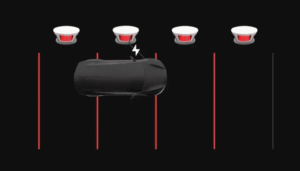
The subject line of this blog article makes things sound better than they are. The real situation is that starting now, the owner of a Ford CCS1 EV can try to place an order for an adapter to be able to charge at Tesla supercharging stations. If and when the owner successfully places the order for the adapter, the owner gets to wait for the adapter to arrive. If and when the adapter arrives, the owner can try to find a Tesla supercharging station at which the charging can be carried out. When the time comes to plug in the Ford CCS1 EV at the Tesla supercharging station, it is likely this will greatly inconvenience other users of the supercharging station.
On May 25, 2023, Ford announced (blog article) that Real Soon Now the owners of Ford EVs would be able to charge at Tesla supercharging stations. Now, after a passage of more than nine months, there is progress.
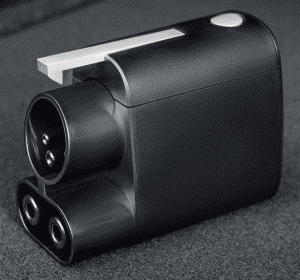 Which vehicles does this apply to? The Ford vehicles to which this applies to are the Mustang Mach-E, the F-150 Lightning, and the Ford E-Transit, in model years 2021 to 2024. (See Ford web page about Tesla charging.) Each of these vehicles has a CCS1 charging port at the left front of the vehicle. Each of these vehicles needs an adapter to be able to charge at a Tesla supercharging station. The adapter permits a Ford EV with a CCS1 charging port to charge using a Tesla supercharger NACS (J3400) charging plug.
Which vehicles does this apply to? The Ford vehicles to which this applies to are the Mustang Mach-E, the F-150 Lightning, and the Ford E-Transit, in model years 2021 to 2024. (See Ford web page about Tesla charging.) Each of these vehicles has a CCS1 charging port at the left front of the vehicle. Each of these vehicles needs an adapter to be able to charge at a Tesla supercharging station. The adapter permits a Ford EV with a CCS1 charging port to charge using a Tesla supercharger NACS (J3400) charging plug.
Does the owner need to pay money to get the adapter? So long as the owner places the order for the adapter on or before June 30, 2024, Ford will provide the adapter free of charge.
There are reports of the Ford order-placement system not being able to keep up with all of the Ford EV owners who are trying to order the adapter.
When will the adapter arrive? Ford does not say exactly when the adapter will arrive. People are reporting that for orders placed now (at the beginning of March 2024), they are being given projected delivery dates in May 2024.
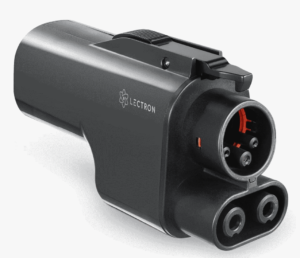
What about third-party NACS-to-CCS1 adapters? Several companies, including Lectron, sell NACS-to-CCS1 adapters. (See Lectron Vortex adapter, shown at right.) Both Ford and Tesla discourage the use of third-party NACS-to-CCS1 adapters. The thing is that both the Ford adapter and the Lectron adapter are very simple. They merely rearrange the connector pins as necessary to match the pin locations for the two kinds of plug. There is no “smarts” of any kind in the adapter. So long as the third-party adapter is well made, with proper insulation ratings and proper current-carrying capability, it ought to work well. I think it is very likely that the Lectron Vortex adapter would work just fine.
Avoiding incompatible Tesla superchargers. It turns out that only some Tesla superchargers can be used with this adapter for fast DC charging of Ford EVs. The charging works only at (newer) V3 superchargers, and does not work at (older) V2 superchargers. (See this blog article that discusses the differences between V2 and V3 superchargers.) As a fun fact, one way that a person can figure out whether they are looking at a V2 or V3 supercharger is by looking at the charging plug.
| V2 supercharger | V3 supercharger | |
| works for Ford EVs | no | yes |
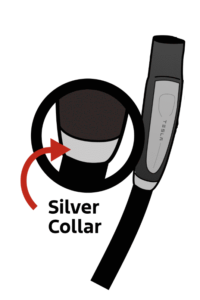 |
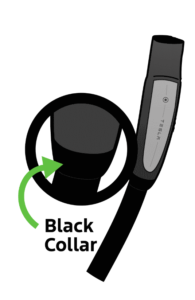 |
As of right now (March 2024) the number of V3 charging kiosks in the US is about 15,000. For the owner of a Ford CCS1 EV, the use of this adapter approximately doubles the number of places where the owner can accomplish fast DC charging.
Getting the charging to work. The idea is that the charging will be “plug and play”. You simply plug in your Ford EV at the Tesla supercharging station and charging should commence automatically.
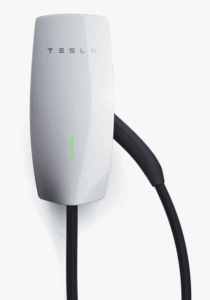 No good for Level 2 chargers. As discussed, above, the NACS-to-CCS1 adapter is no good for Ford CCS1 EVs charging at (older) Tesla V2 superchargers. There is a further limitation, namely that this adapter for fast DC supercharging does not work for charging at a Level 2 charger. (Examples of Level 2 chargers are home chargers and so-called “destination chargers”, shown at right.) You can charge your Ford CCS1 EV at a Level 2 charger, but you would need to use an adapter made specially for Level 2 chargers. Such an adapter might be called “NACS to J1772”.
No good for Level 2 chargers. As discussed, above, the NACS-to-CCS1 adapter is no good for Ford CCS1 EVs charging at (older) Tesla V2 superchargers. There is a further limitation, namely that this adapter for fast DC supercharging does not work for charging at a Level 2 charger. (Examples of Level 2 chargers are home chargers and so-called “destination chargers”, shown at right.) You can charge your Ford CCS1 EV at a Level 2 charger, but you would need to use an adapter made specially for Level 2 chargers. Such an adapter might be called “NACS to J1772”.
Taking up two parking spaces. Unfortunately, the Ford EVs with CCS1 charging ports have the charging port in the wrong place. The charging port is at the left front of the vehicle. In contrast, to make proper use of a Tesla supercharging station, the charging port needs to be at the left rear of the vehicle or at the right front of the vehicle. As Ford explains on its web site:
At most locations, Ford vehicles can park in the parking spot to the right of the Tesla Supercharger they intend to use.
Some Tesla Supercharger site layouts require Ford vehicles to occupy two parking spaces to allow the cable to reach the vehicle. Tesla is aware that Ford vehicles will need to occupy two spaces at these locations.
As a practical matter, this means that almost always, if a Ford CCS1 EV makes use of a Tesla supercharging kiosk, this will inconvenience other EV owners.
As a first example, if the Ford CCS1 EV owner parks in the parking spot to the right of the Tesla Supercharger kiosk that they intend to use, then this makes it impossible for anybody (except maybe another Ford CCS1 EV owner) to make use of the Tesla Supercharger kiosk to the right of the Tesla Supercharger kiosk that they intend to use.
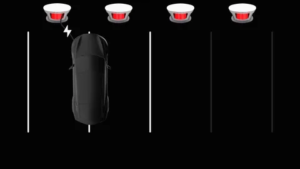 As a second example, if the Ford CCS1 EV owner occupies two parking spaces, this makes it impossible for anybody else to use either of the two parking spaces.
As a second example, if the Ford CCS1 EV owner occupies two parking spaces, this makes it impossible for anybody else to use either of the two parking spaces.

By far the poorest etiquette for the Ford CCS1 EV owner would be to triple-park, as illustrated at right.
A moment’s reflection prompts a thought about a way that owners of Ford CCS1 EVs could try to minimize effects on other users of Tesla charging kiosks — in any row of kiosks, try to use the rightmost kiosk. The idea would be that this might not block any of the other charging positions in the row.
This also prompts a bit of etiquette for owners of Tesla cars. If you have arrived at a V3 charging station, and if two charging kiosks are available, one of which is the rightmost kiosk in a row … take the other one.
What about extension cords? A natural question to ask is, when Ford was designing its NACS-to-CCS1 adapter, why didn’t Ford design it to be an extension cord? (Six feet or so of extra cord length might make up for the charging port on the Ford CCS1 EV being in the wrong place.) The answer is, such a cable would need to have prohibitively heavy-gauge conductors. The charging cable at a V3 charger is water-cooled, and the existence of the water cooling is the only thing that permits the cable to have the limited thickness that it has.
Will Tesla retrofit its existing V3 chargers with longer charging cables? My guess is “no”. The design of the existing V3 chargers neatly stores the cable, when not in use, in the Louboutin recess (blog article) of the kiosk. If a longer cable were to be installed, the cable would drag on the ground when not in use, subjecting the cable to abrasion and risks other kinds of damage.
In future, when the Tesla company is constructing new supercharging stations, maybe it will make the charging cords longer and provide a place for their tidy storage.
This will exacerbate the Osborne Effect. Some would-be purchasers of a non-Tesla EV have already decided to postpone the purchase until such time as the maker of the non-Tesla EV gets its manufacturing act together and makes the charging port a NACS port and puts the port in the right place (the left rear or right front of the vehicle). These postponements are examples of the Osborne Effect (blog article).
In coming months, there will be more and more press reports of (non-Tesla) CCS1 EVs being double-parked at Tesla supercharging stations. It is easy to imagine arguments and flaring tempers when a driver of a Tesla vehicle is forced to wait to charge, while a non-Tesla EV owner blocks access to an otherwise-available charging kiosk. These press reports will surely prompt even more would-be purchasers of a non-Tesla EV to resolve not to make the mistake of purchasing a non-Tesla EV that has a one-foot-in-the-grave CCS1 charging port that is in the wrong place on the vehicle.
What about drivers who decide which charging station to drive to, based upon automated reporting of the number of available kiosks? The Tesla charging network keeps track of the number of kiosks in use and the number of kiosks that are available for use. The latter number shows up in EV route planners, to help a driver figure out which charging station to drive to. But when a Ford CCS1 EV parks in the wrong place, due to its charging port being in the wrong place, this will very likely tie up two kiosks, even though only one kiosk is actually doing any charging. This could easily lead to an erroneously optimistic “available kiosks” number being reported in the route planners.
Maybe the Tesla company will update its network to count a single Ford CCS1 EV as if it were actually occupying two kiosks.
Tesla owners seeking out V2 chargers? One might imagine that some Tesla owners will sometimes actively seek out the older, slower V2 chargers, since those chargers don’t work for non-Tesla vehicles.
Not telling drivers of Ford CCS1 EVs about certain V3 charging stations. One could imagine Tesla picking and choosing which V3 charging stations to report to the route planners used by the Ford CCS1 EVs. If a particular V3 charging station is frequently nearly fully occupied (by Tesla vehicles), maybe Tesla would omit that station from being reported to the Ford CCS1 EV drivers as being available. On the other hand, such an omission might violate some condition of Tesla’s contract with Ford that got signed in in May of 2023.
Nearly all of these problems will go away when Ford does the right thing, switching over its vehicle manufacturing lines to have the charging port in the right place rather than the wrong place, and making the charging port an NACS charging port. The sooner that Ford does this, the better.